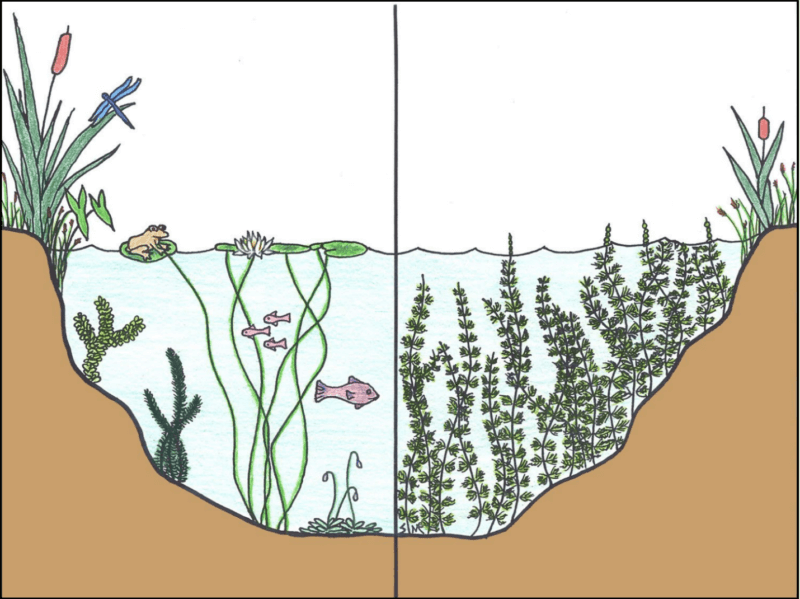Is Eurasian watermilfoil just another weed?
What is Eurasian watermilfoil? Is it just a weed that might be a nuisance but isn’t harmful to lakes and ponds? After all, it has been found in many lakes around the country and has been in some of Vermont’s lakes for decades. Maybe it should be considered native now that it has been here for a while. But is it really just another weed that has now “naturalized”? The answer is no, and here’s why.
According to the U.S. Department of Agriculture, Eurasian watermilfoil “threatens the diversity and abundance of native plants as well as the ecological balance of lakes and ponds, which in turn adversely affects recreational opportunities. If left unchecked, invasive watermilfoil will spread through a lake, or even to other lakes by transmission.”
Eurasian watermilfoil is a non-native species. Some non-native species, when introduced into a new environment, won’t necessarily spread uncontrollably and become a problem. Those that become invasives will thrive in the new environment and spread out of control. With no natural predators in our environment, Eurasian watermilfoil is an invasive.

Japanese knotweed and buckthorn are examples of terrestrial invasives. The Burmese python that is devastating the Everglades is another example. By outcompeting native species, these invasives overwhelm and in some cases destroy native ecosystems. The damage these land-based invasives do is easy to see while the damage an invasive like Eurasian watermilfoil does to the aquatic habitat is more difficult to see but nevertheless is there.
Eurasian watermilfoil outcompetes native aquatic plants that fish and amphibians need to thrive. This loss of aquatic habitat has reverberations throughout the ecosystem, leading to critical changes that affect not just the waterbody itself but the surrounding watershed and the humans and wildlife that depend on that water resource. Once an ecosystem is out of balance, mother nature can’t just adapt. The destruction of native habitats will continue unless something is done to stop the invasive from spreading.
If milfoil is left alone, it grows out of control, creating dense canopies on the water’s surface, robbing sunlight from native aquatic species, thereby stunting or completely suppressing their growth. Those surface mats of Eurasian watermilfoil prevent boating and swimming and start to rot, stink and foul the water. As these large infestations die back each year, they decompose on the lake bottom, adding to nutrient levels in the lake which then feed toxic cyanobacteria blooms. Such excessive amounts of rotting vegetation also can reduce the oxygen in the water, causing wildlife to die, and further damaging the aquatic ecosystem.
Aquatic plants grow in the shallower parts of lakes called the littoral zone, where light can penetrate. This is where Eurasian watermilfoil is found. It usually grows in depths to about 14 feet, but it has been found as deep as 30 feet. With Vermont’s wonderfully clean and clear lakes, Eurasian watermilfoil can easily spread to those depths.
In smaller lakes where the littoral zone is a larger percentage of the lake area, it is easy to see how Eurasian watermilfoil can take over, squeezing out native aquatic plants, and destroying aquatic habitats. However, in larger and very deep lakes, like Lake Champlain, where the littoral zone is a smaller percentage of the total lake area, it can seem like Eurasian watermilfoil is not such a problem, even if it has infested much of the littoral zone. Boats can churn through it and out into the large open area where no milfoil is seen – where, in fact, no aquatic plants are seen because none grow there.
It would be a very serious mistake, however, to think that just because you don’t see milfoil growing in the middle of a large lake it is not a problem. The health of a lake’s littoral zone is vital to the health of that lake. A healthy Vermont lake has several dozen native aquatic plant species. Without a wide variety of native aquatic plant species, native fish, amphibians, and other wildlife will decrease and the natural ecosystem will tip out of balance.
One of the great difficulties in controlling Eurasian watermilfoil and protecting aquatic habitats is how easily it spreads. A brittle plant, pieces break off easily and those fragments sink to the lake bottom, root, and grow quickly. Anything that disturbs these plants and causes such fragmentation — boats, swimmers, paddlers, wind or waves — will add to the spread. Even some control methods such as mechanical harvesting (essentially mowing), or hand pulling, can cause fragmentation and lead to further spread.
Is invasive Eurasian watermilfoil just another weed that can be left in Vermont’s lakes? Not if you value the health of Vermont’s lakes. Don’t be lulled into thinking that Eurasian watermilfoil is “just a weed.” As the U.S. Fish & Wildlife Service points out at http://tinyurl.com/ytxe85jt, “Invasive species cause tremendous harm to our environment, economy and health.”
We humans introduced this and other invasives into our waterbodies, so it is our responsibility to work to control or eradicate them. Help your local lake association protect and preserve Vermont’s lakes, ponds, and watersheds by working to prevent and control this insidious invasive.
To learn more about Eurasian watermilfoil, visit the Federation of Vermont Lakes and Ponds milfoil page: vermontlakes.org/eurasian-watermilfoil.
(Pat Suozzi, who lives in Hinesburg, is the president of the Federation of Vermont Lakes and Ponds.)
